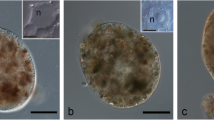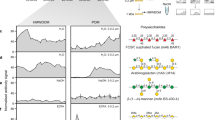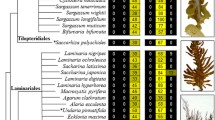Summary
Extracellular polysaccharide/proteoglycan (EPS) mucilages play a crucial role in maintaining the structure of the extensive algal sheets that appear along the undersurface of nearshore Antarctic sea ice during the austral spring. In this study we have determined the composition and ultrastructural location of a family of novel sulphated polysaccharides/proteoglycans from the pennate ice diatomStauroneis amphioxys Gregory. They occur as soluble EPS in the culture supernatant, as an intercellular mucilage sheet, and as components of a distinct organic layer (diatotepum) underlying the silicious cell wall. The ultrastructural location and quantitative extraction of the mucilage EPS and the major diatotepum polysaccharides with hot water and alkali, respectively, was monitored by light and electron microscopy. The EPS and wall components were purified by Ultrafiltration, anion exchange and gel filtration chromatographies, and their monosaccharide composition was determined by gas-chro-matography mass spectrometry. The soluble and mucilage EPS, and major diatotepum polysaccharides/proteoglycans had an apparent molecular mass greater than 2 × 106 Da on gel. They contained a similar complex monosaccharide composition that includes glucuronic acid and galactose as the major sugars and significant levels of rhamnose, fucose, arabinose, xylose, mannose, glucose and the mono-O-methylated monosaccharides 3-O-methylrhamnose, 3-O-methylfucose, 3-O- and 4-O-methylxylose. The ratios of Gal to GlcA, which together account for 45% of the monosaccharides, varied from 0.8 (in the soluble EPS) to 2.3 (in diatotepum polysaccharides). The level of sulphation also varied from 5–15% (w/w), with the mucilage EPS being the most highly sulphated. The soluble EPS also contains a small amount of protein (ca. 5%, v/w) which cochromatographs with the polysaccharide during gel filtration and anion exchange chromatographies suggesting that it may be a sulphated proteoglycan. They are clearly distinct from a sulphated glucuronomannan that remained in the alkali-insoluble fraction and may be tightly associated with the silica wall components. The amount of mucilage EPS increased during logarithmic growth but decreased during stationary phase, when most of the EPS was found in the soluble pool. These changes correlate with the breakdown of the mucilage sheet and dispersal of diatom colonies during stationary growth. Interestingly, the soluble EPS from stationary-growth cultures was indistinguishable from the mucilage EPS of logarithmic- or stationary-phase cells, suggesting that the dissolution of the intercellular mucilage was not due to a change in EPS composition. The possibility that cell motility may be required for mucilage formation and the significance of these polysaccharides in the under-ice community is discussed.
Similar content being viewed by others
References
Allan GG, Lewin J, Johnson PG (1972) Marine polymers IV: diatom polysaccharides. Bot Mar 15: 102–108
Blakeney AB, Harris PJ, Stone BA (1983) A simple and rapid preparation of alditol acetates for monosaccharide analysis. Carbohydr Res 113: 291–299
Bradford MM (1976) A rapid and sensitive method for the quantitation of microgram quantities of proteins utilizing the principle of dye-binding. Anal Biochem 72: 248–254
Crawford RM (1973) The organic component of the cell wall of the marine diatomMelosira nummuloides (Dillw.) C.Ag. Br Phycol J 8: 257–266
Coombs J, Volcani BE (1968) Studies on the biochemistry and fine structure of silica shell formation in diatoms: chemical changes in the wall ofNavicula pelliculosa during its formation. Planta 82: 280–292
Dawson PA (1973) Observations on the structure of some forms ofGomphoneema parvulum Kutz III: frustule formation. J Phycol 9: 353–365
Dodgson KS, Price RB (1962) A note on the determination of the ester sulphate content of sulphated polysaccharides. Biochem J 84: 106–110
Drum RW, Hopkins JJ (1966) Diatom locomotion: an explanation. Protoplasma 62: 1–33
Edgar LA, Pickett-Heaps JD (1982) Ultrastructural localization of polysaccharides in the motile diatomNavicula cuspidata. Protoplasma 113: 10–22
— — (1983) The mechanism of diatom locomotion I: an ultrastructural study of the motility apparatus. Proc R Soc Lond B Biol Sci 218: 331–343
Fichtinger-Schepman AMJ, Kamerling JP, Vliegenthart JFG, De Jong EW, Bosch L, Westbroek P (1979) Composition of a methylated acidic polysaccharide associated with coccoliths ofEmiliana huxleyi (Lohmann) Kampter. Carbohydr Res 69: 191–189
Ford CW, Percival E (1965) The carbohydrates ofPhaeodactylum tricomutum, part I: preliminary examination of the organism and characterization of low molecular weight material and of a glucan. J Chem Soc 1965: 7035–7041
Green JW (1963) Drying and reactivity of cellulose. Methods Carbohydr Chem 3: 95–103
Guillard RRL, Ryther JH (1962) Studies of marine planktonic diatoms I:Cyclotella nana Hustedt andDetonula conferuacea (Cleve) Gran. Can J Microbiol 8: 229–239
Haug A, Myklestead S (1976) Polysaccharides of marine diatoms with special reference toChaetoceros species. Mar Biol (Berlin) 19: 323–331
Hoagland KD, Rosowski JR, Gretz MR, Roemer S (1993) Diatom extracellular polymeric substances: function, fine structure, chemistry and physiology. J Phycol 29: 537–566
Kroger N, Bergsdorf C, Sumper M (1994) A new calcium binding glycoprotein family constitutes a major diatom cell wall component. EMBO J 13: 4676–4683
— — — (1996) Frustilins: domain conservation in a protein family associated with diatom cell walls. Eur J Biochem 239: 259–264
Lind JL, Heimann K, Miller EA, van Vliet C, Hoogenraad NJ, Wetherbee R (1997) Substratum adhesion and gliding in a diatom are mediated by extracellular proteoglycans. Planta 203: 213–221
McConville MJ (1985) Chemical composition and biochemistry of sea ice algae. In: Horner RH (ed) The ice biota. CRC Press, Boca Raton, pp 152–165
—, Wetherbee R (1983) The bottom-ice microalgal community from annual ice in the inshore waters of East Antarctica. J Phycol 19: 431–439
—, Mitchell C, Wetherbee R (1985) Patterns of carbon assimilation in a microalgal community from annual sea ice, East Antarctica. Polar Biol 4: 35–141
—, Bacic A, Clarke AE, Ikeda T (1986) The nature of digestive carbohydrases particularly (l–3)-β-D-glucan hydrolases from the hepatopancrease of Antarctic krill,Euphausia superba and E.crystallorophasis. Mar Biol 90: 371–378
McCully ME, Goff LJ, Adshead PC (1980) Preparation of algae for light microscopy. In: Gant D (ed) Handbook for phycological methods. Cambridge University Press, London, pp 263–284
Paulsen BS, Myklestad S (1978) Structural studies of the reserve glucan produced by the marine diatomSkeletonema costatum (Gev.) Cleve. Carbohydr Res 62: 386–388
Percival E, Foyle RAJ (1979) The extracellular polysaccharides ofPorphyridium cruentum andPorphyridium aerugineum. Carbohydr Res 72: 165–176
—, Rahman MA, Weigel H (1980) Chemistry of the polysaccharides of the diatomCoscinodiscus nobilis. Phytochemistry 19: 809–811
Rae AL, Harris PJ, Bacic A, Clarke AE (1985) Composition of the cell walls ofNicotiana alata (Link and Otto) pollen tubes. Planta 166: 128–133
Reimann BEF, Lewin JC, Volcani BE (1965) Studies on the biochemistry and fine structure of silica shell formation in diatoms I: the structure of the cell wall ofCylindrotheca fusiformis Reimann and Lewin. J Cell Biol 4: 39–55
— — — (1966) Studies on the biochemistry and fine structure of silica shell formation in diatoms II: the structure of the cell wall ofNavicula pelleculosa (Breb.) Hilse. J Phycol 2: 74–84
Schnepf E, Drebes G (1977) The structure of the frustule ofAttheya decora West (Bacillariophyceae, Biddulphiineae) with special reference to the organic compounds. Br Phycol J 12: 145–154
—, Deichgraber G, Drebes G (1980) Morphogenetic process inAttheya decora (Bacillariophyceae, Biddulphiineae). Plant Syst Evol 135: 265–277
Stoemer EF, Pankratz HS, Bowen CC (1965) Fine structure of the diatomAmphipleura pellucida II: cytoplasmic fine structure and frustule formation. Am J Bot 52: 210–216
Stosch HA von, Reimann BEF (1970)Subsilicea fragelarioides gen et spec, nov., eine Diatomee (Fagilariaceae) mit vorwiegend organischer Membran. Nova Hedwigia Beih 31: 1–36
Volcani BE (1981) Role of silicon in diatom metabolism and silicification. In: Simpson TL, Volcani BE (eds) Silicon and siliceous structures in biological systems. Springer, New York Berlin Heidelberg, pp 157–200
Wang Y, Lu J, Mollet J-C, Gretz MR, Hoagland KD (1997) Extracellular matrix assembly in diatoms (Bacillariophyceae) II: 2,6-dichlorobenzonitrile inhibition of motility and stalk production in the marine diatomAchnanthes longipes. Plant Physiol 113: 1071–1080
Wetherbee R, Lind JL, Burke J, Quatrano RS (1998) The first kiss: establishment and control of initial adhesion by raphid diatoms. J Phycol 34: 9–15
Wustman BA, Gretz MR, Hoagland KD (1997) Extracellular matrix assembly in diatoms (Bacillariophyceae) I: a model of adhesives based on chemical characterization and localization of polysaccharides from the marine diatomAchnanthes longipes and other diatoms. Plant Physiol 113: 1059–1069
Author information
Authors and Affiliations
Rights and permissions
About this article
Cite this article
McConville, M.J., Wetherbee, R. & Bacic, A. Subcellular location and composition of the wall and secreted extracellular sulphated polysaccharides/proteoglycans of the diatomStauroneis amphioxys Gregory. Protoplasma 206, 188–200 (1999). https://doi.org/10.1007/BF01279266
Received:
Accepted:
Issue Date:
DOI: https://doi.org/10.1007/BF01279266




